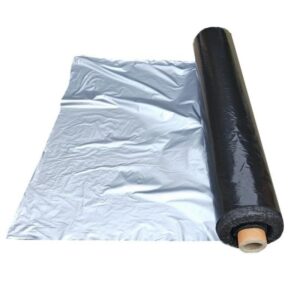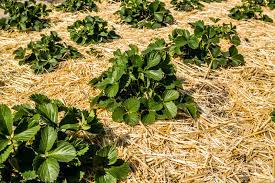Mulching Paper Price In Kenya
Grekkon Limited’s low density polyethylene (LDPE) mulching paper price in Kenya is a factor of plastic mulch paper thickness given in microns. We supply silver on black mulch paper in different thicknesses to high value crop growers in Africa.
Our plastic mulch paper is UV treated to prevent rapid solar degradation when in use. Our available thicknesses are; 30 micron, 60 micron and 70 micron. Our mulch paper is in rolls of 1,000M x 1.6M. We cut it longitudinally from this roll according to a grower’s need. The company also installs, and trains first time growers on how to make planting holes on plastic mulch paper
Does Water Go Through Plastic Mulch?
Overhead water sources such as rain or sprinkler irrigation won’t penetrate the plastic to get to the soil
Can You Use Plastic Mulch Without Drip Irrigation?
Yes. Irrigation is done by pouring water in the holes where the plants are. This is a tedious and time consuming process
Advantages of Plastic Mulch
i. Early start for crops. Plants take off with vigor because they have sufficient moisture retained within their root zones. Again the warmth retained in the soil hastens crop growth.
ii. Reduces water wastage. Water loss resulting from evaporation is largely reduced which saves on daily irrigation operational costs.
iii. Less upkeep. Mulch paper stifles weeds which saves weeding operational costs, removes competition for nutrients and light against the crop by weeds.
iv. Better crop quality. Mulched crops have better yield quality as a result of less disease and pest attack, and a more vigorous growth.

Strawberry production in a tunnel house using silver on black mulch paper by Grekkon Limited to cover the ground. Location: Jua Kali area, Laikipia county
Disadvantages
- It is not biodegradable
- It is more expensive to use than organic waste mulch
- Irrigation is limited to drip irrigation
i. What is purpose of mulching paper?
- To retain soil moisture by preventing moisture loss through evaporation
- To prevent weed growth
Mulching accelerates crop growth due to mositure retention, and better feeding 9reduced competition for food and light with weeds). This cuts the time the crop remains in the field, which reduces operational costs. Better feeding equals better yield, and higher income

Silver on black mulch paper in a herbs cropping field at Heni area, Nyandarua county
The silver coloured part faces up to reflect excess heat, while the black part faces down to retain warmth
The choice of mulch paper thickness depends on;
- Crop growing duration. For short term, single or 2 season crops, a grower will pick the 30 micron paper which will last as long. For long-term crops such as bi-annuals and perennials, the farmer will install the thickest gauge
- Budget. The thicker it is, the costlier the paper
ii.How much mulching paper do I need for 1 acre?
Assume that a nacre measures 63.3M x 63.3M, with 1M wide beds, with paths of 0.5M in between. This gives a total of 42 beds, each running 63M in length. To get the total amount of mulching paper, multiply the number of beds, by the bed length and the width of the mulching paper as below;
42beds x 63.3M x 1.6M = 4,234M sq
iii. What is the cost of mulching per acre?
The cost of your mulching paper cost per acre will be 4,234M sq by the cost per meter square of your chosen thickness. These are tabulated below
Mulching paper price in Kenya
| Mulch Paper Thickness | Price in Kes |
| 30 micron | 20/ M SQ |
| 60 micron | 35/M SQ |
| 70 micron | 45/ M SQ |

A silver on black mulching paper roll. Smaller mulching paper needs are cut from this as per the grower’s specifications
iv. Which crops need mulching?
This is for high value crops. In Kenya, examples are;
- export herbs and spices
- strawberry
- apples
- greenhouse tomato, cucumber, capsicums, and chilies
v. What are the 3 benefits of mulch?
- ensures soil moisture retention
- cuts down weeding costs
- the crops grow faster and more uniformly
vi. What is the disadvantage of mulching paper?
- it is expensive
- it is an environmental hazard after use because it has to be burned
- it does not allow in rain water, so the crop is fully reliant on irrigation
vii. Which is the best mulching paper?
The thicker it is, the longer it lasts. However, budget considerations are made based on how long the cropping season is, and the need to mulch in the next season
viii. What are the 2 types of mulch?
- organic mulch. This is from crop waste and grass straw
- inorganic mulch. This is made from plastic (LDPE)

Organic mulch from grass straw in a strawberry field
ix. How long does plastic mulch last?
Depending on the thickness, it is as follows
30 microns; 2-3 cropping seasons
60 micron; 4-5 cropping seasons
70 micron; > 6 cropping seasons
x. How do you install mulching paper?
- prepare the land to a fine tilth
- make raised beds, and remove any large soil clods. These will cause air trapping in the paper
- cover the top and sides of the bed with the mulching paper
- perforate holes on the plastic mulch where the crop will be planted
xi. When should you use mulching paper?
- When growing high value crops such as; strawberry, coloured bell peppers, greenhouse tomato, herbs and spices
- If there is insufficient or expensive irrigation water. Mulching will conserve moisture in the soil, reducing irrigation water costs dramatically
- If there is a high prevalence of stubborn weeds. Mulc paper will suppress their growth

Herbs (chives) growing in a greenhouse under plastic mulch paper
xii. What is plastic mulchpaper made of?
Polyethylene
xiii. What is an alternative to mulching paper?
Organic mulch. This is from straw, leaves, shredded bark, shredded newspaper, hay, sawdust or wood chips, cardboard, manure, or other organic matter
xiv. How thick is mulching paper?
Grekkon Limited supplies 30 microns, 60 microns, 70 microns, and 80 microns plastic mulch paper
Our mulching paper price in Kenya is similar across all our branches in Athi River, Nairobi, Kisumu, Eldoret, Nyeri, and Nyahururu
